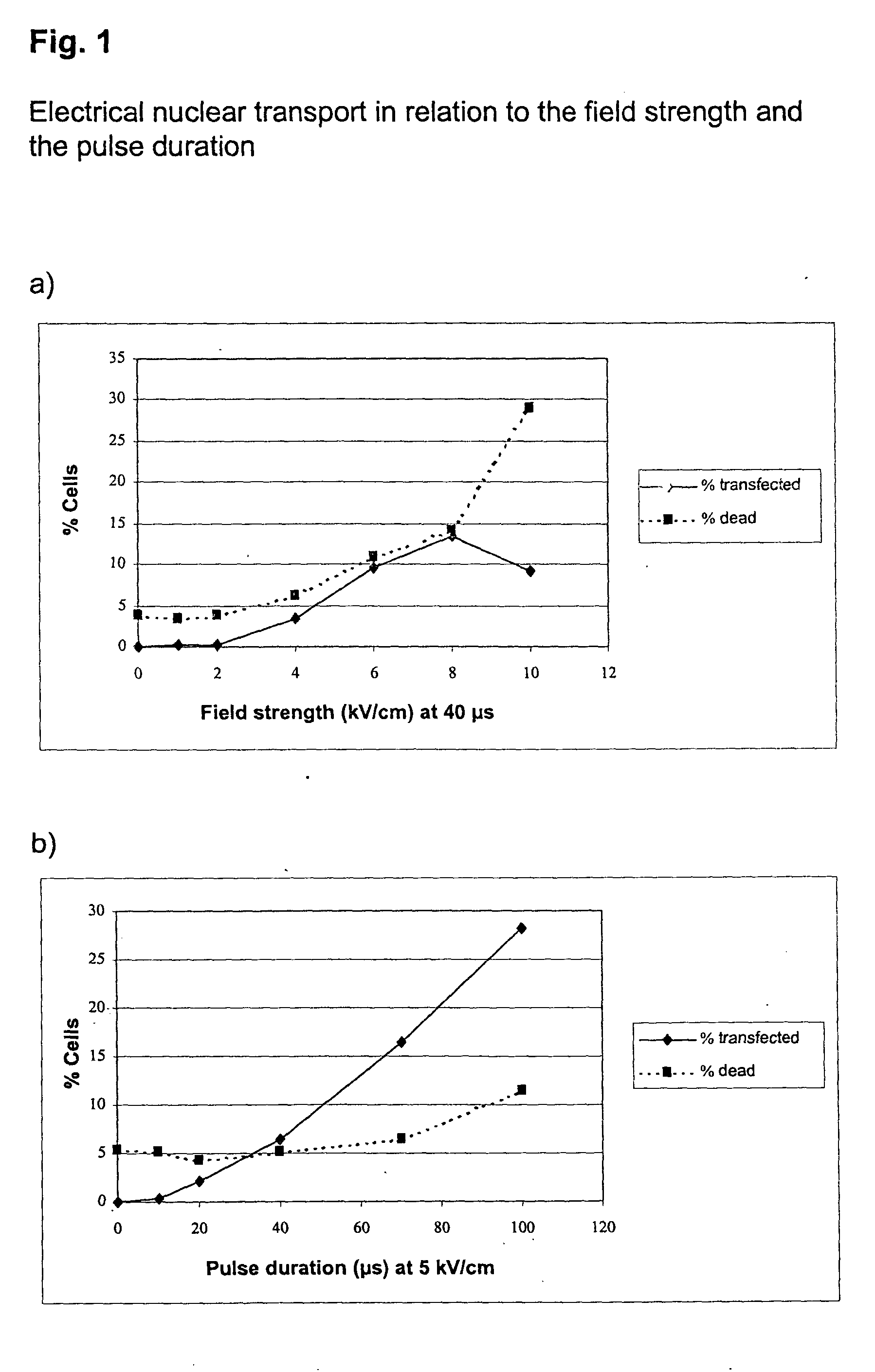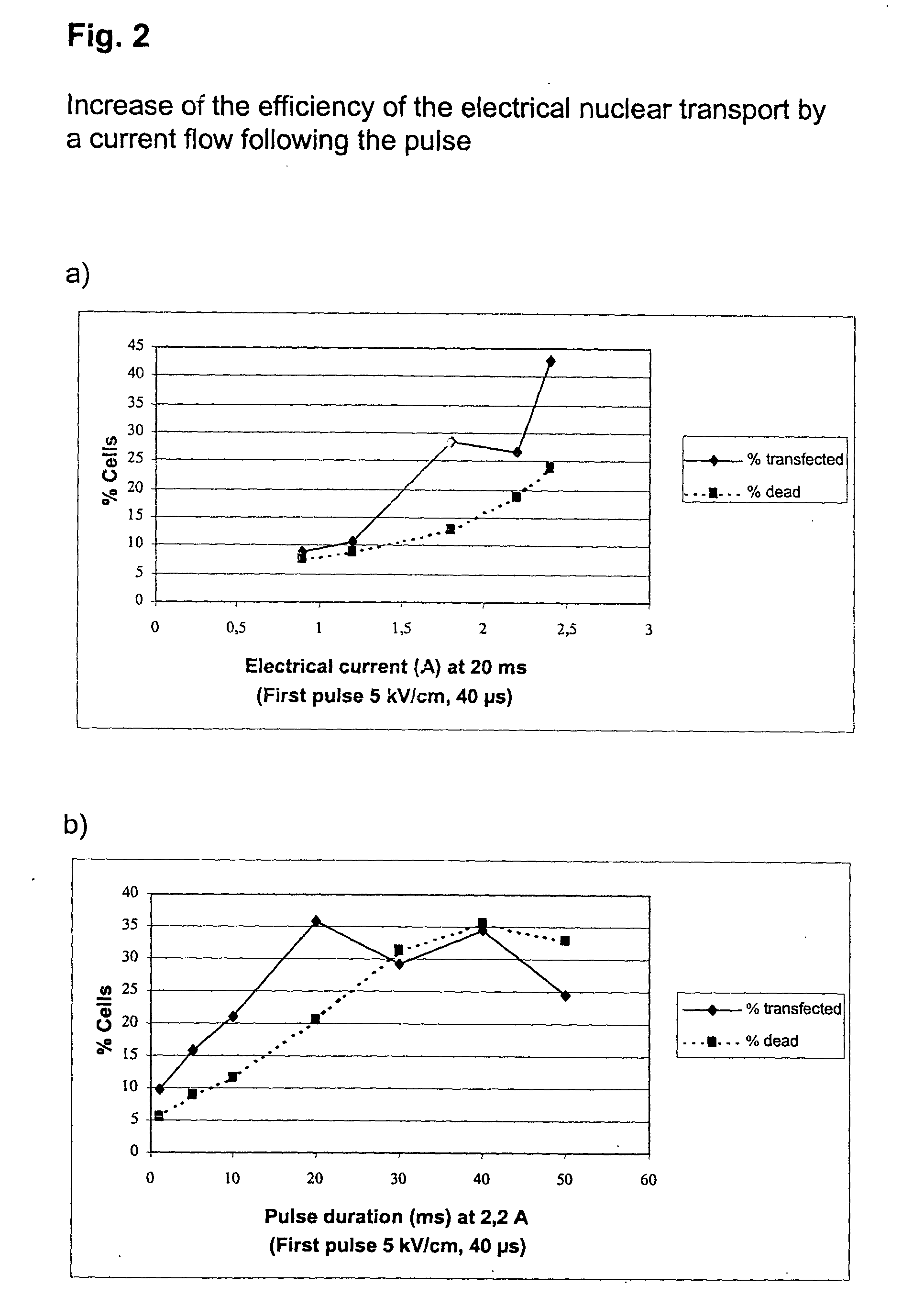Method for introducing nucleic acids and other biologically active molecules into the nucleus of higher eukaryotic cells by means of an electrical current
an electrical current and nucleus technology, applied in the direction of genetic material ingredients, peptides, drug compositions, etc., can solve the problems of low cell mortality, no known method addresses the electrically targeted introduction of dna into the nucleus of higher eukaryotic cells, and no known method addresses the problem
- Summary
- Abstract
- Description
- Claims
- Application Information
AI Technical Summary
Benefits of technology
Problems solved by technology
Method used
Image
Examples
example 1
[0057] Electrical Nuclear Transport in Relation to the Field Strength and the Pulse Duration
[0058] Freshly prepared unstimulated (non dividing) mononuclear cells from peripheral human blood (PBMC) were transfected with a vector coding for the heavy chain of the murine MHC class I protein H-2K.sup.k. 1.times.10.sup.6 cells together with 10 .mu.g vector DNA in buffer 1 were transferred at room temperature into a cuvette with 2 mm electrode spacing, and were transfected under the described conditions. Immediately afterwards, the cells were rinsed out of the cuvette with 500 .mu.l RPMI medium (without fetal calf serum, FCS), incubated for 10 min at 37.degree. C, and were then transferred to a culture dish with prewarmed medium (with FCS). After 5 h incubation, the cells were subsequently incubated with the digoxigenin-coupled anti-H-2K.sup.k antibody and then with the Cy5-coupled anti-digoxygenin antibody, as well as with a phycoerythrin (PE)-coupled anti-CD4 antibody for identification...
example 2
[0060] Increase of the Efficiency of the Electrical Nuclear Transport by a Current Flow Following the Pulse
[0061] Freshly prepared unstimulated PBMC were transfected with an H-2K.sup.k expression vector as described in example 1. A pulse of 5 kV / cm for 40 .mu.s was followed without interruption by a current flow of different strengths and duration. After 5 h incubation the cells were analyzed as in example 1, and the transfection efficiency of T helper cells was determined (FIG. 2).
example 3
[0062] Transfection of PBMC
[0063] Freshly prepared unstimulated PBMC were, as described in example 1, transfected with an H-2K.sup.k expression vector by a 40 .mu.s pulse of 5kV / cm, followed by a current flow of 2.2 A for 20 ms, and were analyzed as in example 1.
[0064] FIG. 3 shows the analysis of the portion of transfected cells in the CD4-positive and the CD4-negative fractions of the PBMC. 36% of the CD4.sup.+ cells and 19% of the CD4.sup.- cells express the transfected DNA. Three fourths of the mortality rate of 26% are due to the transfection procedure.
PUM
| Property | Measurement | Unit |
|---|---|---|
| Time | aaaaa | aaaaa |
| Time | aaaaa | aaaaa |
| Current | aaaaa | aaaaa |
Abstract
Description
Claims
Application Information
 Login to View More
Login to View More - Generate Ideas
- Intellectual Property
- Life Sciences
- Materials
- Tech Scout
- Unparalleled Data Quality
- Higher Quality Content
- 60% Fewer Hallucinations
Browse by: Latest US Patents, China's latest patents, Technical Efficacy Thesaurus, Application Domain, Technology Topic, Popular Technical Reports.
© 2025 PatSnap. All rights reserved.Legal|Privacy policy|Modern Slavery Act Transparency Statement|Sitemap|About US| Contact US: help@patsnap.com



